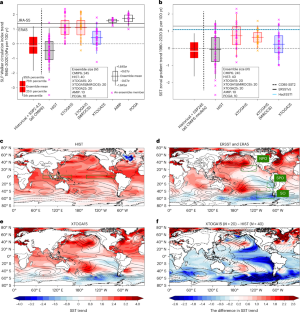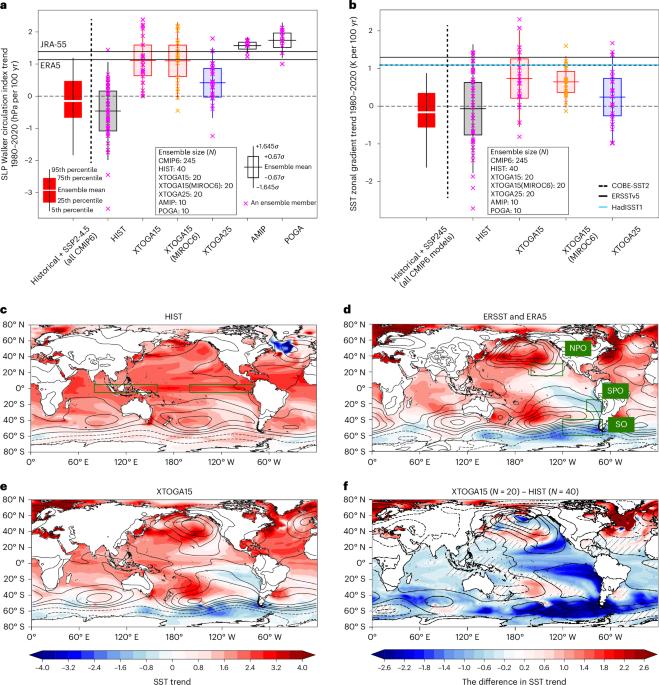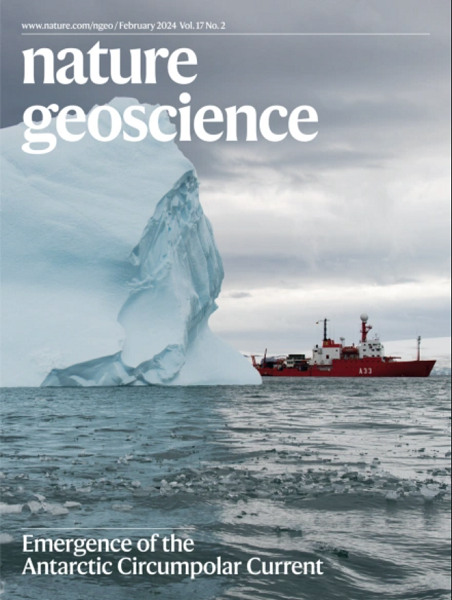热带以外海面温度变化驱动沃克环流加强
IF 15.7
1区 地球科学
Q1 GEOSCIENCES, MULTIDISCIPLINARY
引用次数: 0
摘要
太平洋沃克环流--热带太平洋大气的带状倾覆环流--以及与之相关的热带太平洋海面温度分布对全球气候有重大影响。然而,气候模式的历史模拟无法捕捉到自 1980 年左右以来观测到的沃克环流增强现象。虽然人们提出了许多机制来解释观测到的变化,但定量讨论和协调模式-观测差异的线索尚未解决。我们在这里指出,1980-2020 年间沃克环流的增强可以用副热带和外热带海面温度变化的远距离影响来定量解释。这一结论是通过气候模式起搏器实验得出的,在该实验中,热带以外的海表温度异常向观测值恢复。东南太平洋的影响使东热带太平洋降温,对沃克环流的加强尤为重要。这种向赤道的影响主要是通过大气层及其与海洋的热耦合产生的。我们进一步发现,目前的气候模式在东南太平洋表面温度变化方面存在偏差,这可能是导致沃克环流趋势无法再现的原因。我们的研究结果表明,改进对该地区海气耦合的表述可以更好地预测未来气候。本文章由计算机程序翻译,如有差异,请以英文原文为准。


Walker circulation strengthening driven by sea surface temperature changes outside the tropics
The Pacific Walker circulation—the tropical Pacific zonal overturning circulation of the atmosphere—and the associated sea surface temperature distribution in the tropical Pacific significantly impact global climate. However, climate model historical simulations cannot capture the observed Walker circulation enhancement since around 1980. Although a number of mechanisms have been proposed to explain the observed change, quantitative discussion and clues for reconciling the model-observation discrepancy have not yet been settled. Here we show that the Walker circulation strengthening between 1980 and 2020 can be quantitatively explained by the remote influence of subtropical and extratropical sea surface temperature changes. This conclusion is obtained from climate model pacemaker experiments in which sea surface temperature anomalies outside the tropics are restored towards observations. Influence from the southeastern Pacific, which cools the eastern tropical Pacific, is especially crucial for the Walker circulation strengthening. This equatorward influence occurs mostly through the atmosphere and its thermal coupling with the ocean. We further show that current generation climate models have biases in southeastern Pacific surface temperature changes, which may cause the failure in reproducing the Walker circulation trend. Our results suggest that improved representation of air–sea coupling in this region could enable better projections of future climate. Subtropical and extratropical sea surface temperature changes can explain recent observed Walker circulation strengthening, according to climate model experiments.
求助全文
通过发布文献求助,成功后即可免费获取论文全文。
去求助
来源期刊

Nature Geoscience
地学-地球科学综合
CiteScore
26.70
自引率
1.60%
发文量
187
审稿时长
3.3 months
期刊介绍:
Nature Geoscience is a monthly interdisciplinary journal that gathers top-tier research spanning Earth Sciences and related fields.
The journal covers all geoscience disciplines, including fieldwork, modeling, and theoretical studies.
Topics include atmospheric science, biogeochemistry, climate science, geobiology, geochemistry, geoinformatics, remote sensing, geology, geomagnetism, paleomagnetism, geomorphology, geophysics, glaciology, hydrology, limnology, mineralogy, oceanography, paleontology, paleoclimatology, paleoceanography, petrology, planetary science, seismology, space physics, tectonics, and volcanology.
Nature Geoscience upholds its commitment to publishing significant, high-quality Earth Sciences research through fair, rapid, and rigorous peer review, overseen by a team of full-time professional editors.
 求助内容:
求助内容: 应助结果提醒方式:
应助结果提醒方式:


